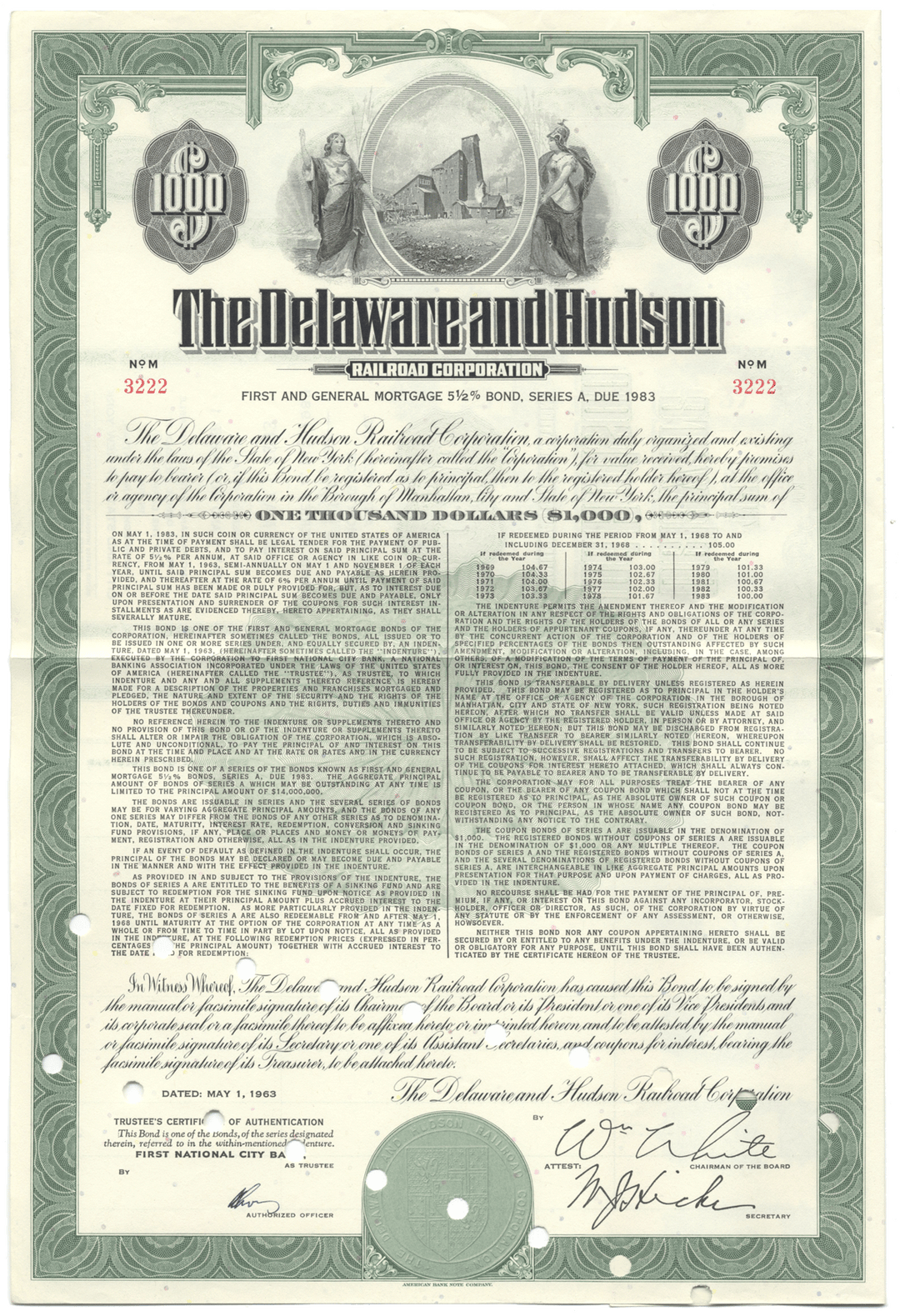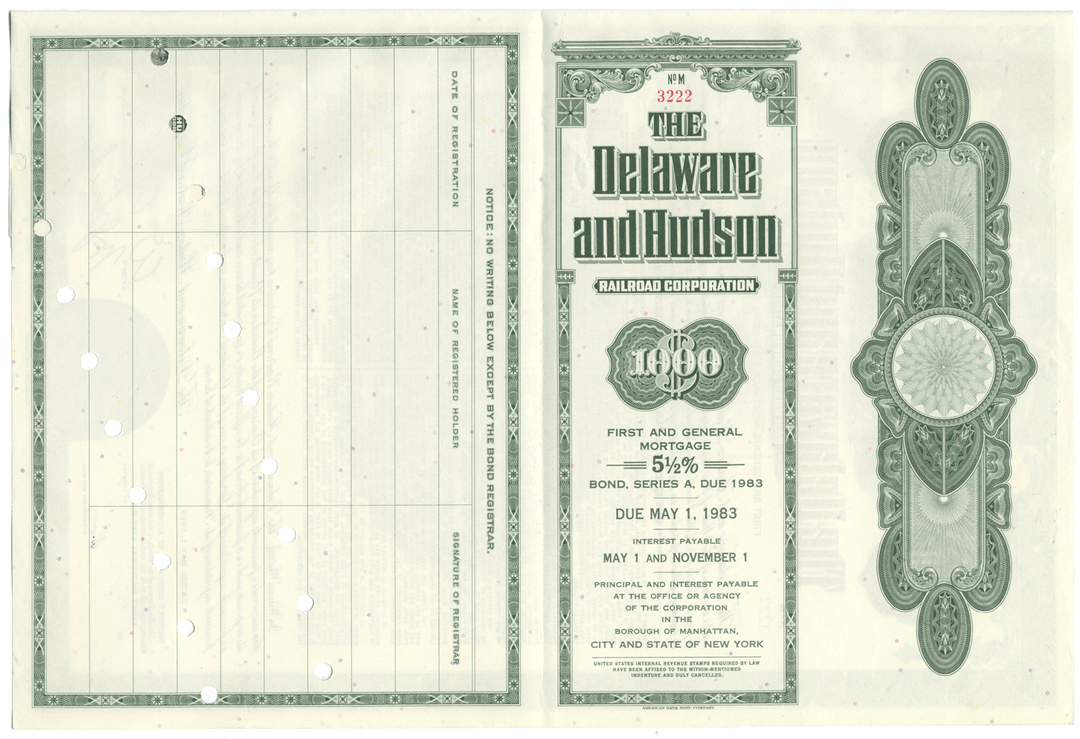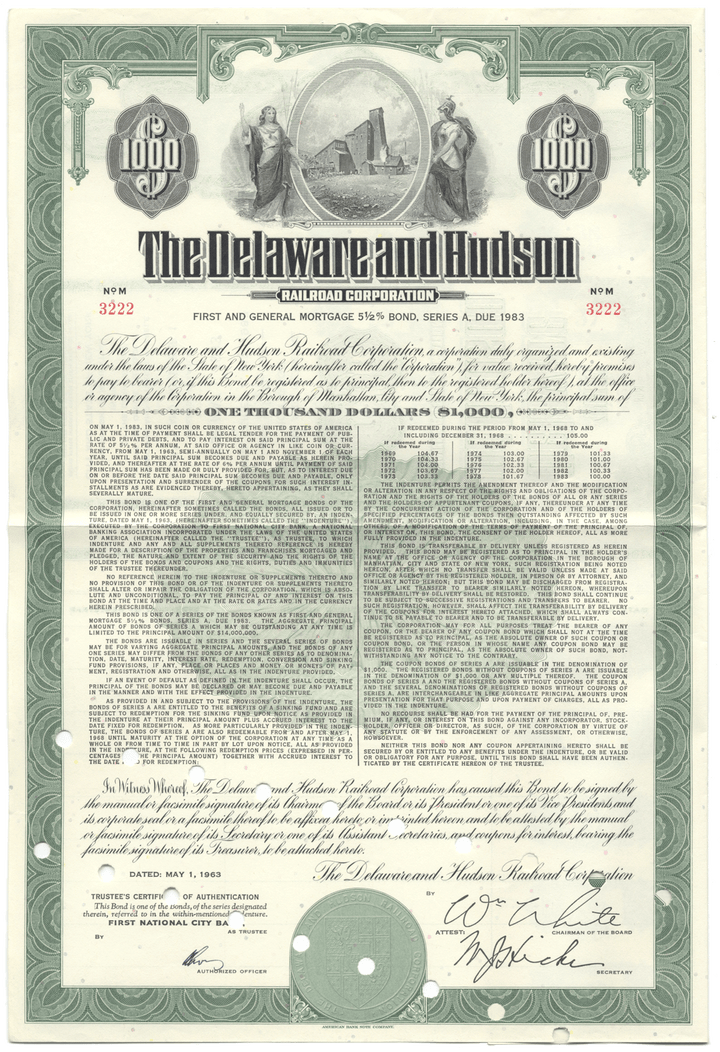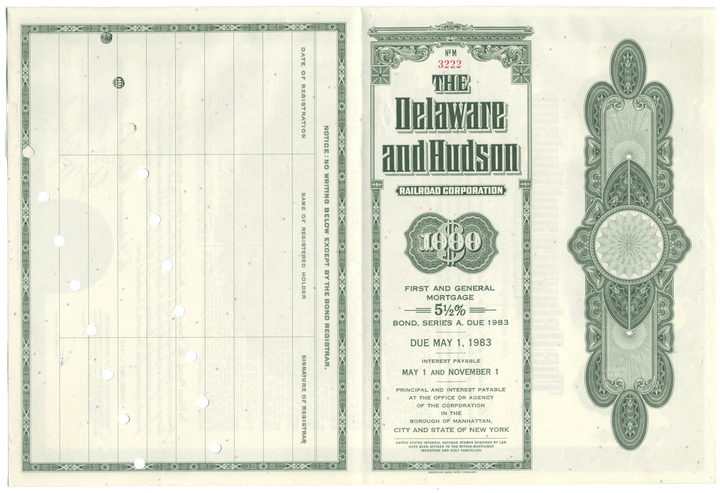Delaware and Hudson Railroad Corporation
- Only 1 available!!
- Backordered, shipping soon
- Guaranteed authentic document
- Orders over $35 ship FREE to U. S. addresses
Product Details
Company
Delaware and Hudson Railroad Corporation
Certificate Type
First and General Mortgage Bond
Date Issued
May 1, 1963
Canceled
Yes
Printer
American Bank Note Company
Signatures
Machine printed
Approximate Size
10 1/4" (w) by 15" (h)
Images
Show the exact certificate you will receive
Guaranteed Authentic
Yes
Additional Details
NA
Historical Context
As railroads grew in popularity, the Delaware and Hudson Canal Company recognized the importance of replacing the canal with a railroad. The first step of this was the Jefferson Railroad, a line from Carbondale north towards New York, chartered in 1864, built by the Erie Railroad in 1869 and opened in 1872. This was a branch of the Erie, running south from the main line at Lanesboro to Carbondale. Also built as part of this line was a continuation from the other side of the D&H's gravity railroad at Honesdale southeast to the Erie's Pennsylvania Coal Company railroad at Hawley. The Jefferson Railroad (and through it the Erie) obtained trackage rights over the D&H between its two sections, and the D&H obtained trackage rights to Lanesboro.
The other part of the main line was the Albany and Susquehanna Railroad, which the D&H leased on February 24, 1870. The Delaware and Hudson already had a history of working with the Albany and Susquehanna, agreeing in 1866 to jointly build an extension to Nineveh and subsequently ship coal across the entire line. The two companies then entered into an arrangement whereby the Delaware and Hudson perpetually leased the Albany and Susquehanna for $490,000 per year. The connecting Lackawanna and Susquehanna Railroad, chartered in 1867 and opened in 1872, was also absorbed. The Albany and Susquehanna provided a line from Albany southwest to Binghamton, while the Lackawanna and Susquehanna split from that line at Nineveh, running south to the Jefferson Railroad at Lanesboro. Also leased in 1870 was the Schenectady and Susquehanna Railroad, connecting the Albany and Susquehanna at Duanesburg to Schenectady, opened in 1872 (reorganized as the Schenectady and Duanesburg Railroad in 1873).
On March 1, 1871, the D&H leased the Rensselaer and Saratoga Railroad Company, which, along with its leased lines, provided a network stretching north from Albany and Schenectady to Saratoga Springs, and continuing northeast to Rutland, Vermont, as well as an eastern route to Rutland via trackage rights over the Troy and Boston Railroad west of Eagle Bridge. The D&H also obtained a 1/4 interest in the Troy Union Railroad from this lease.
On March 1, 1873, the D&H got the New York and Canada Railroad chartered as a merger of the Whitehall and Plattsburgh Railroad and Montreal and Plattsburg Railroad, which had been owned by the Rutland Railroad. This provided an extension north from Whitehall to the border with Quebec, completed in 1875; a branch opened in 1876 to Rouses Point. Lines of the Grand Trunk Railway continued each of the two branches north to Montreal.
The D&H obtained trackage rights over the Lehigh and Susquehanna Railroad in 1886, extending the main line southwest from Scranton to Wilkes-Barre.
On July 11, 1889, the D&H bought the Adirondack Railway, a long branch line heading north from Saratoga Springs along the Hudson River.
Some company directors questioned the wisdom of acquiring extensive rail systems in northern New York State. A direct line to Albany, New York existed for many years through the canal and river system, so most of the coal markets in the area were already accessible. These concerns were overruled by the majority, who believed there would be great benefit to having an all rail route to Upstate New York that was not nearly as vulnerable to winter weather as the canal. It was also desirable to avoid situations in which the company would have to rely on other railroads to reach its markets. The effort was helped by a report that estimated necessary upgrades to the canal would cost $300,000, an expenditure that would not be needed if rail routes could be purchased or leased.
The canal was last used on November 5, 1891, and the gravity railroad closed January 3, 1899. On April 28, 1899 the name was changed to the Delaware and Hudson Company to reflect the lack of a canal, which was sold in June of that year. Between Port Jackson and Ellenville, the right-of-way for the canal was used by the Ellenville and Kingston Railroad, a branch of the New York, Ontario and Western Railway, chartered in 1901 and opened in 1902.
In 1903, the D&H organized the Chateaugay and Lake Placid Railway as a consolidation of the Chateaugay Railroad, Chateaugay Railway and Saranac and Lake Placid Railway. In conjunction with the Plattsburgh and Dannemora Railroad, which had been leased by the Chateaugay Railroad, this formed a long branch from Plattsburgh west and south to Lake Placid.
In 1906, the D&H bought the Quebec Southern Railway and South Shore Railway, merging them into the Quebec, Montreal and Southern Railway. This line ran from St. Lambert, a suburb of Montreal, northeast to Fortierville, most of the way to Quebec City. The D&H sold that line to the Canadian National Railway in 1929.
The D&H incorporated the Napierville Junction Railway in 1906 to continue the line north from Rouses Point to St. Constant Junction near Montreal, Quebec, from which the D&H obtained trackage rights over the Grand Trunk Railway to Montreal. This line opened in 1907, forming part of the shortest route between New York City and Montreal.
In 1912, the D&H and the Pennsylvania Railroad incorporated the Wilkes-Barre Connecting Railroad, creating an interchange between the two lines at Hanover Township, PA, thus avoiding going through downtown Wilkes-Barre. Opened in 1915, it runs north 6.65 miles to the D&H mainline at Hudson crossing the Susquehanna River twice.
On April 1, 1930, the property of the Delaware and Hudson Company was transferred to the Delaware and Hudson Railroad Corporation, incorporated December 1, 1928. In 1938, the D&H started to act as a bridge line, carrying large amounts of freight between other connecting lines.
Related Collections
Additional Information
Certificates carry no value on any of today's financial indexes and no transfer of ownership is implied. All items offered are collectible in nature only. So, you can frame them, but you can't cash them in!
All of our pieces are original - we do not sell reproductions. If you ever find out that one of our pieces is not authentic, you may return it for a full refund of the purchase price and any associated shipping charges.








